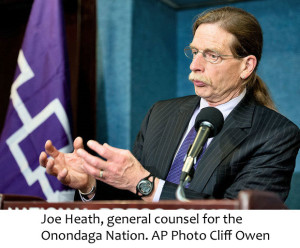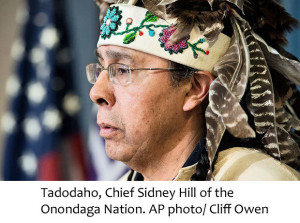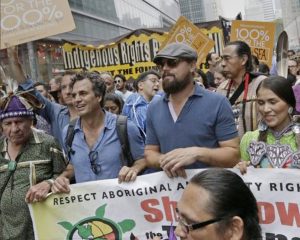
April 8, 2020
In April 2020, New York State Governor presented a budget which caused celebration on the Onondaga Nation. The Budget halted Hydro Fracking in New York State.
In the time leading up to the 2005 Onondaga Nation Land Rights Case, the Onondaga Nation Council made a decision that would make a change in how the Court System, State and Federal officials, and environmentalists viewed the Onondaga Nation.
Land Rights Action
“I remember working closely with the Council, especially with leaders like the Late Clan Mother Audrey Shenandoah, Faithkeeper Oren Lyons and the Late Chief Irving Powless Jr, in crafting our case,” said General Counselor for the Onondaga Nation, Joe Heath. “Leaders like these made the Onondaga case like no other.”
 But the Onondaga Nation didn’t plan to file a case.
But the Onondaga Nation didn’t plan to file a case.
Other Haudenosaunee (Iroquois) nations had filed Land Claims against New York State in order to re-establish land for its people and monetary amount to rectify the wrongs committed by NYS. The Onondaga Nation instead negotiated with the State and the Federal government to find a suitable solution. An agreement was near until the State Governor Patatki said that negotiations were immediately halted until the Onondaga Nation filed a case against the State.
“We were very surprised when the State stopped negotiating with us,” said Tadodaho Chief Sidney Hill. “But we as a Nation have always maintained an equal government to government relationship that we have always abided by.”
“When the case was finally constructed, we were very thoughtful to convey the morals and principles that had guided the Onondaga Nation for countless centuries,” said Heath. “The case stated what the Nation has always stated: that NYS violated federal treaties and broke federal laws in taking Onondaga lands and that the Creator has given them the duty of stewards of the land and the living things that depend on it.”
Below is the opening statement of the 2005 Onondaga Land Rights case.
“The Onondaga People wish to bring about a healing between themselves and all others who live in this region that has been the homeland of the Onondaga Nation since the dawn of time. The Nation and its people have a unique spiritual, cultural, and historic relationship with the land, which is embodied in Gayanashagowa, the Great Law of Peace. This relationship goes far beyond federal and state legal concepts of ownership, possession or legal rights. The people are one with the land, and consider themselves stewards of it. It is the duty of the Nation’s leaders to work for a healing of this land, to protect it, and to pass it on to future generations. The Onondaga Nation brings this action on behalf of its people in the hope that it may hasten the process of reconciliation and bring lasting justice, peace, and respect among all who inhabit the area.”
At the March 2005 press conference announcing the Land Rights Action, Syracuse reporters asked what does healing Onondaga Lake mean?
 Chief Hill responded, “To be able to drink the water and eat the fish.”
Chief Hill responded, “To be able to drink the water and eat the fish.”
The late Clan Mother Audrey Shenandoah added, “We not only seek justice for the people of the Onondaga Nation, but we seek justice for the winged animals, the free animals, and the waters that provide life to us all.”
After 5 years, the United States Federal court never allowed the case to be argued in court, stated that it was too disruptive to the people of NYS if the case was won by the Onondagas, and dismissed the case in 2010.
Advocacy throughout the State
“We set up a communications office that was manned by Jeanne Shenandoah to handle the complaints,” said Chief Hill. “But we didn’t receive any. Instead we received so many requests for help.”
The Onondaga Nation then became an advocate for water [like Onondaga Creek] and land issues throughout the State.
“We were at first helping out local governments and environmental groups to hold the EPA to enforce higher remedies to the polluters,” stated Heath. “We were then alerted of gas companies hiring ‘land men’ to begin renting farming land for fracking well for methane, a/k/a/ ‘natural’ gas. This definitely sounded an alarm in the Nation.”
The Onondaga Nation is a sovereign nation. For the Onondagas, that means they do not accept any aide from NYS or the USA that is not delineated in the 1794 Canandaigua Treaty. Using its own funds, the Nation built a water system for its citizens that was based on a huge natural underground water aquifer on the edge of its border with the USA.
“We were very concerned that nearby land owners had signed leases to allow fracking in the watershed of the springs that feed our water system,” said Chief Hill. “The drilling would eventually have a detrimental effect on our water system and the water to all of the people living on the Nation.”
The Onondaga Nation began an informational program about the dangers of fracking and developed legal documents that provided local farmers a way to discourage the gas companies from renting their lands.
Joining Forces
The Onondaga Nation first received help from the Haudenosaunee Environmental Task Force (HETF). The HETF played a key leadership role being the first party to call for an outright ban on fracking, while other organizations were only calling for regulations. The Nation and HETF continuously stated that fracking is too destructive and cannot be done safely. Soon other organizations learned that banning fracking was the only proper goal.
“We were very busy in the beginning,” said Heath. “Jeanne Shenandoah and I were making presentations in different communities. We had great people like Katie Nadeau and Lindsay Speer working around the clock, connecting to different advocacy groups and State leaders. Our speaking engagements took us to hundreds of towns and went on until the end of 2014.”
Faithkeeper Oren Lyons and the late Clan Mother Audrey Shenandoah first began going to the United Nations in the early 1970s. There they were one of the first indigenous leaders to address the UN about the issues facing native communities.
In one of his first comments to the UN, Lyons stated, “We are here to speak for those who do not have a seat here, the eagle, the buffalo, and the waters.”
“Over the years of his work at the UN, Oren had nurtured many contacts in the environmental field,” said Heath. “Organizations such as Riverkeepers Alliance, Frack Action, New Yorkers against Fracking, Catskill Mountain Keepers, Fleased and many others; and people like  Pete Seger, Leonardo Decaprio, Yoko Ono and Mark Ruffalo provided not only provided encouragement to keep doing our work, but also provided valuable resources.”
Pete Seger, Leonardo Decaprio, Yoko Ono and Mark Ruffalo provided not only provided encouragement to keep doing our work, but also provided valuable resources.”
The 2020 NYS Budget
Then in April of 2020, NYS Governor Cuomo released the State budget halts Hydro Fracking in NYS.
In its April 1, 2020 press release, celebrating the permanent ban, Catskill Mountainkeeper quoted Mark Ruffalo: “While Trump is rolling back environmental regulations, [state leaders] are protecting our water, air, land and public health by enshrining the fracking ban into state law. Thank you to our elected leaders and all the New Yorkers and the Onondaga Nation and Native people who dedicated their time and energy to organizing the anti-fracking movement.”
Heath stated, “This frack resistance was the largest grass roots movement in the state in over 100 years, and it drew upon the collective efforts of hundreds of thousands of people who joined to protect the water and the lands.”
In its April 3rd press release, Frack Action also noted the leadership role of the Nation, “Thank you to all those who forged the way including the Onondaga Nation and Haudenosaunee Confederacy. Thank you to Oren Lyons, Tadodaho Sid Hill, Betty Lyons and all our indigenous brothers and sisters for teaching us again and again to love our Mother Earth. And allies Joe Heath and Lindsay Speer for all your incredible work both with the Nation and the movement and all those in the grassroots.”
“We all were so surprised when we saw the budget,” said Chief Hill. “We were thankful that all of the work we did ended up helping Mother Earth and her waters.”
With the announcement of no fracking in the budget for 10 years, the Nation and many others hope NYS looks to renewable energy for its energy needs.
“I have learned from my time with Onondaga the importance of leaving this world better for the seventh generation coming. I think that renewable energy can help achieve that,” said Heath. “The Onondaga and other indigenous voices have made this clear. I am glad that the governor was able to hear that message.
“I am hopeful for the future,” said Chief Hill. “We all know how important water is to survive. Every drop is sacred.”
